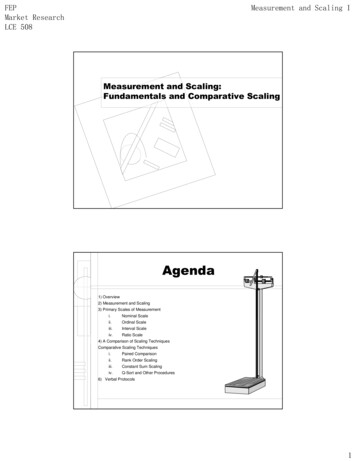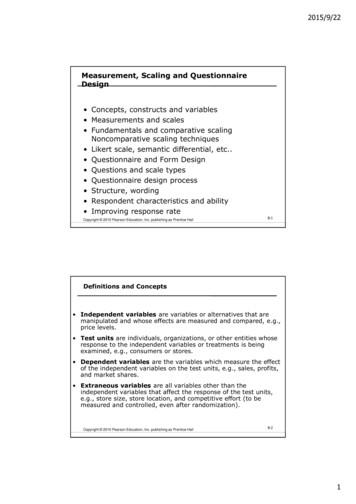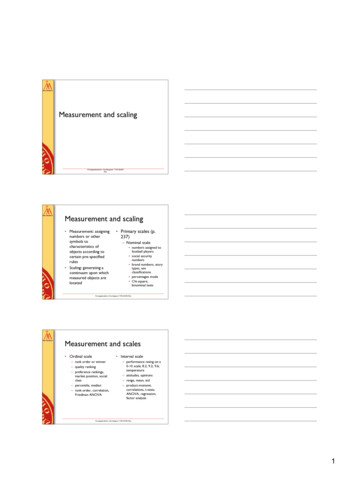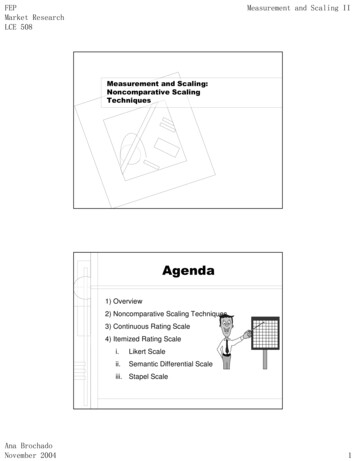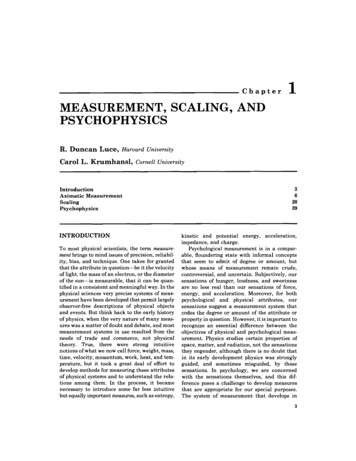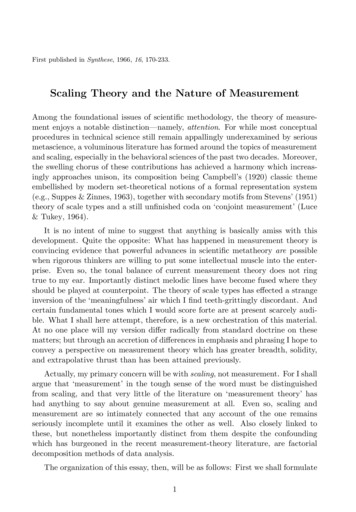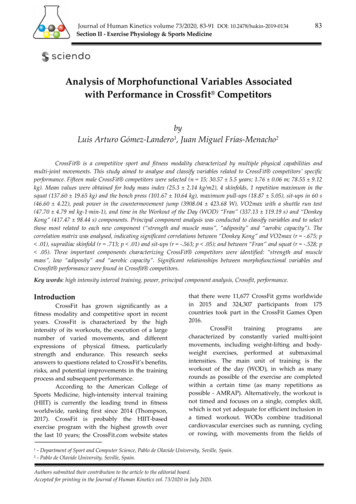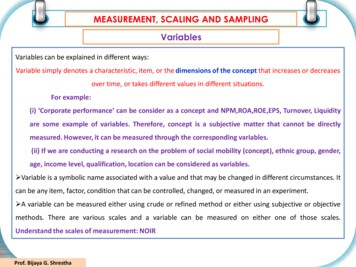
Transcription
MEASUREMENT, SCALING AND SAMPLINGVariablesVariables can be explained in different ways:Variable simply denotes a characteristic, item, or the dimensions of the concept that increases or decreasesover time, or takes different values in different situations.For example:(i) ‘Corporate performance’ can be consider as a concept and NPM,ROA,ROE,EPS, Turnover, Liquidityare some example of variables. Therefore, concept is a subjective matter that cannot be directlymeasured. However, it can be measured through the corresponding variables.(ii) If we are conducting a research on the problem of social mobility (concept), ethnic group, gender,age, income level, qualification, location can be considered as variables. Variable is a symbolic name associated with a value and that may be changed in different circumstances. Itcan be any item, factor, condition that can be controlled, changed, or measured in an experiment. A variable can be measured either using crude or refined method or either using subjective or objectivemethods. There are various scales and a variable can be measured on either one of those scales.Understand the scales of measurement: NOIRProf. Bijaya G. Shrestha
Type of VariablesIndependentVariables[Experimental orPredictor]Mediating ariable[Outcome orCriterion]ProductivityModerating Variables[Conditional orInteraction]Age
Type of VariablesA variable is called independent if it is not influenced by any other variable under study. Anindependent variable, sometimes called an experimental or predictor variable, is a variable that isbeing manipulated in an experiment in order to observe the effect on a dependent variable,sometimes called an outcome variable. A variable is called dependent (criterion) if its valuesdepend upon other variable/s.A moderator variable, is a third variable that affects the strength or direction of the relationshipbetween a dependent and independent variable. A moderating variable is a second independentvariable that has been selected for study in order to determine if it affects or modifies the basicrelationship between the primary independent variable and the dependent variable.A mediator or intervening variable is that factor which theoretically affects the observedphenomenon but cannot be seen, measured or manipulated because they usually have to do withan individuals feelings e.g. fatigue, boredom, excitement, intention, motivation etc. Interveningvariable explains the relationship between the dependent and the independent variables likeCategorical variables are also known as discrete or qualitative variables. Categorical variables canbe further categorized as either nominal or ordinal. Nominal variables are variables that have twoor more categories, but which do not have an intrinsic order or ranked. Ordinal variables arevariables that have two or more categories just like nominal variables but the categories can alsobe ordered or ranked.Prof. Bijaya G. Shrestha
Type of VariablesCategorical variables are also known as discrete or qualitative variables. Categorical variables canbe further categorized as either nominal or ordinal.Nominal variables are variables that have two or more categories, but which do not have anintrinsic order or ranked. For example, gender is a categorical variable having two categories (maleand female) and we assign the number 1 for male, 2 for female but, there is no intrinsic ordering tothe categories. Here, 2 is not higher than 1.The next example, hair color is a nominal variable having a number of categories (blonde, brown,black, red, etc.) and again, we can assign the numbers 1, 2, 3, 4 etc. but, there is no agreed way toorder these from highest to lowest. Here, 4 is not higher than 1.An ordinal variable is similar to a nominal, to some extent. The difference between the two is thatthere is a clear ordering of the variables in ordinal. For example, suppose you have a variable,economic status, with three categories (low, medium and high). We can order the categories aslow, medium and high. Say we assign scores 1, 2, and 3 to these three levels .Even though we can order these from lowest to highest, the spacing between the values may notbe the same across the levels of the variables.If these categories were equally spaced, then the variable would be an interval variable.Sometimes we have variables that are “in between” ordinal and interval, for example, afive-point likert scale with values “strongly agree”, “agree”, “neutral”, “disagree” and“strongly disagree”. If we cannot be sure that the intervals between each of these fivevalues are the same, then we would not be able to say that this is an interval variable, butwe would say that it is an ordinal variable.Prof. Bijaya G. Shrestha
Type of VariablesA discrete variable is one that can not take value between two numbers. It refers to the one thathas a certain number of values. For example: Sibling in a family.A continuous variable is one that can take any value between two numbers.For example, weight of different individuals: Between 52 and 82 kg, there are a lot of possibilities:One person might be 64.0354 kg weight, and another person might be 72.6709 kg. And, there areliterally millions of other possible weights between 62 and 82 kgs. Therefore, a continuous variableimplies the one that can take any value between a given range.Scales of MeasurementProf. Bijaya G. Shrestha
Attitude Measurement and Scale ConstructionAttitude can be defined as a tendency to react favorably, neutrally, or unfavorably toward variousaspects of the world. It is a person's inherent qualities of mind and character.It is a tendency to respond in a certain manner.Attitude is a subjective and personal matter. It is a point of view (a feeling or opinion) aboutsomething or someone that influences an individual's behavior. Therefore, opinion of a person isthe verbal expression of attitude.Attitude can be formed from a person's past and present. The attitude of a person is determined bypsychological factors like ideas, values, beliefs, perception, etc.Measurement is the assignment of numbers to characteristics of something or someone,according to rules. It is oriented to measure something.The term number given in the definition of measurement are used as symbols/numbers torepresent certain characteristics of the object and it does not mean addition, subtraction,division or multiplication.Scaling is the way of measurement.Attitude measurement is the mechanism for measuring the abstract concepts.There are two challenges a researcher faces when measuring an individual's attitude.First, an individual's attitude toward an object cannot be observed directly but must be inferredfrom observed behavior, such as responses to a questionnaire.And second, there is no inherent scale associated with the observed behavior.Prof. Bijaya G. Shrestha
Attitude Measurement and Scale ConstructionIn anorganization,understandingthe attitudesare importantfor their goalor objectiveto succeed.Componentsof AttitudeIn a typicalresearch ofsocial science,differentcomponentsare measuredby theappropriatescales.Prof. Bijaya G. ShresthaAffectiveThe feelings oremotionstoward anobjectBehavioralPredispositionor tendency toaction.CognitiveKnowledge andbeliefs about anobjectIt represents feelings or emotions that peoplehave toward an object (Joy, happiness, andsatisfaction, anger, frustration etc.). Itmeasures people’s like or dislike for aparticular object.Statements such as "I like this" or "I preferthat" reflect the affective component of anattitude.It refers to an intention to act in a certainway toward someone or something.Affective and Cognitive components aremajor determinant of the behavioralcomponent of attitude.An officer gives equal opportunity toboth male and female because hebelieve that ‘discrimination is wrong.’It is related to the beliefs, knowledge,and thoughts that people have about theobject.For example: You may have belief inreincarnation, or rebirth.An officer may have thought that“Discrimination is wrong"
Attitude Measurement and Scale ConstructionAttitude measurement relates to the process of measuring an individual's attitude towards anobject. When we go for measurement of attitudes or any other parameter, one has to clearly sortout the following : "what" has to be measured ? "who" is to be measured ? the accuracy desired in the measurement the costs permissible the choices available in the measurement/data collection techniques.In attitude measurement, the researcher is primarily interested in measuring the "state of mind" ofthe respondent (s).It may include factors such as awareness, attitudes and decision processes.An interesting characteristics of these measures is that their verification is rather difficult.Ranking, Rating, Sorting and Choice are the techniques (mechanisms) for developing attitudescales.Prof. Bijaya G. Shrestha
Attitude Scales Commonly used in Social Science ResearchLikert Scales Named after its founder, psychologist Rensis Likert, Likert scale is used to understand the levelof feeling/agreement/importance etc. that the respondents have on a particular statement. Insightful Likert scale questions plays a greater role in social science research, specially thesurvey research. Each Likert scale consists of several Likert items. A Likert item is an individual statement or question which asks a person to indicated the extentto which they agree/satisfy/feel the importance/ frequency of using or visiting etc. with severalranked options. Likert items usually offer participants a choice from the several ranked options (e.g.,3; 5;7;9),with the middle option being neutral. The widely used ranked options are 5 and 7. However, there are many evidences of exclusion of the middle point to avoid central tendencyerror. Therefore, odd and even likert scales are possibleYour level ofsatisfaction after usingour products Highly dissatisfied Dissatisfied Neutral Satisfied Highly satisfiedProf. Bijaya G. ShresthaThe organization is active tokeep the employee updatedwith information technologyA researcher can makedifferent style of Likert scalequestionnaire. Strongly disagree Disagree Somewhat disagree Neither agree nor disagree Somewhat agree Agree Strongly agree
Attitude Scales Commonly used in Social Science ResearchSemantic Differential Scale A semantic differential scale is a list of opposite adjectives. The survey answering options are grammatically on opposite adjectives at each end. Sometimes semantic differentials are also known as polarities. The semantic differential scale question asked the respondent to select one (typically from the 7levels), offering two polarized options. It is the most reliable way to get information on people’s emotional attitude towards a topic ofinterest. For example, love / hate, simple / complex with intermediate options in between. The respondents’ attitude would be the sum of the numbers corresponding to the positionschecked on the individual subscales (or average).How do you rate the teen agers of Kathmandu valley on the followingdimensions:Gentle : : : : : : ViolentFlexible : : : : : : InflexibleHonest : : : : : : DishonestPessimistic : : : : : : OptimisticEnergetic : : : : : : UnenergeticLikert and Semantic Differential, both questions serve the same relative purpose. But theway in which the question is asked and the response terms used (as well as how the answerchoices are listed) can make a huge difference.Prof. Bijaya G. Shrestha
Attitude Scales Commonly used in Social Science ResearchStapel Scale It is a unipolar (one adjective) rating scale designed to measure the respondent’s attitudetowards the object or event. This scale was named after its developer, Jan Stapel. This scale is usually presented vertically. The data obtained by using a staple scale can be analyzedin the same way as a semantic differential data.There is no neutral point in a staple scalequestion which means each option candescribe the objective.Prof. Bijaya G. ShresthaThe semantic differential allows for a neutralpoint which means that a survey respondentcan leave a question unanswered if the thebipolar objectives do not appropriately definethe experience.
Attitude Scales Commonly used in Social Science ResearchRank Order Rating ScalesThe rank order rating scale is widely used to measurepreference for an object. It focuses on ordinal measurement.For example:As your feeling, place a ‘1’ next to the brand that is most reliable, a ‘2’next to the brand that is most reliable, and so on. Remember, no twobrands can have the same rating.SuzukiHyundaiMahindraTATAChevroletDifferent types of questions inquestionnaireDemographic questionsMultiple choice questionsSimple category/DichotomousquestionsRanking questionsClose ended questionsOpen-ended questionsNumerical ScalesNumerical scales of measuring the attitude uses number options to respondents instead of verbal expressions.It looks similar as Semantic Differential Scales. Because, it also uses bipolar adjectives. But, it provides anumeric symbolization of an attribute and the numbers are provided with interval properties beyond justordinal properties. It can be 5-point, 7-point and so on. For example, it can be requested to give number toexpress level of satisfaction in different attributes:Please rate your level of satisfaction with our service: Extremely satisfied 5 4 3 2 1 Extremely dissatisfiedRoomsBreakfastLaunchDinnerStaffsProf. Bijaya G. Shrestha
Criteria of Good Measurement: Validity and Reliability of MeasurementValidity referstothe truthfulness offindings.The major concernof validity is:“Whether theresearch trulymeasures what itwas intended for.”Types ofValidityIf an instrument (forexample,questionnaires orscale design etc.)does not measureac
The term number given in the definition of measurement are used as symbols/numbers to represent certain characteristics of the object and it does not mean addition, subtraction, division or multiplication. Scaling is the way of measurement. Attitude measurement is the mechanism for measuring the abstract concepts.


